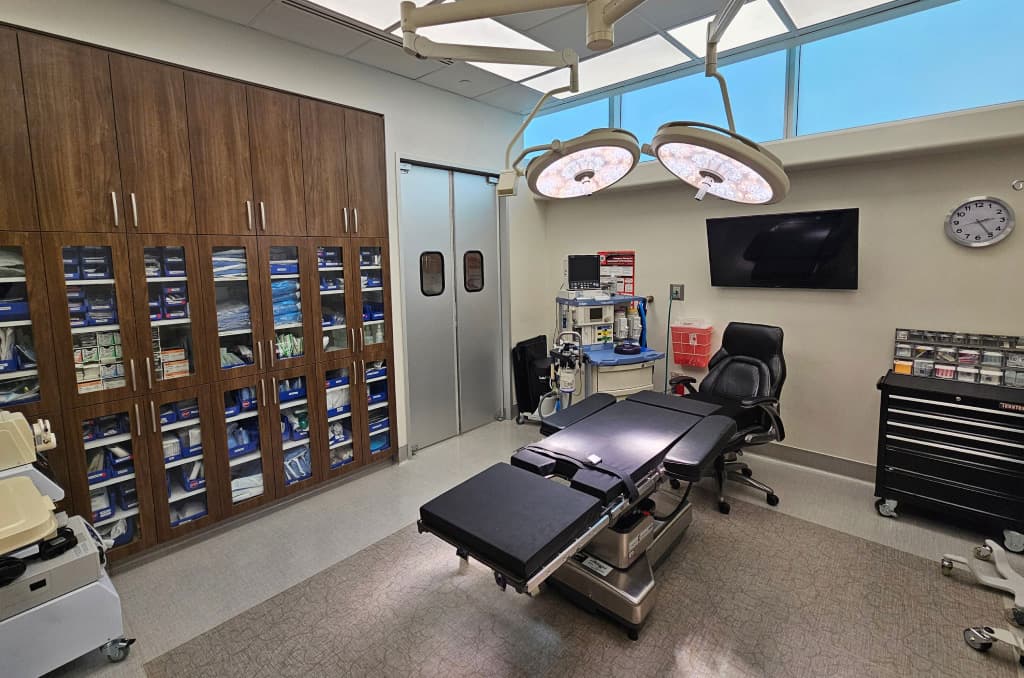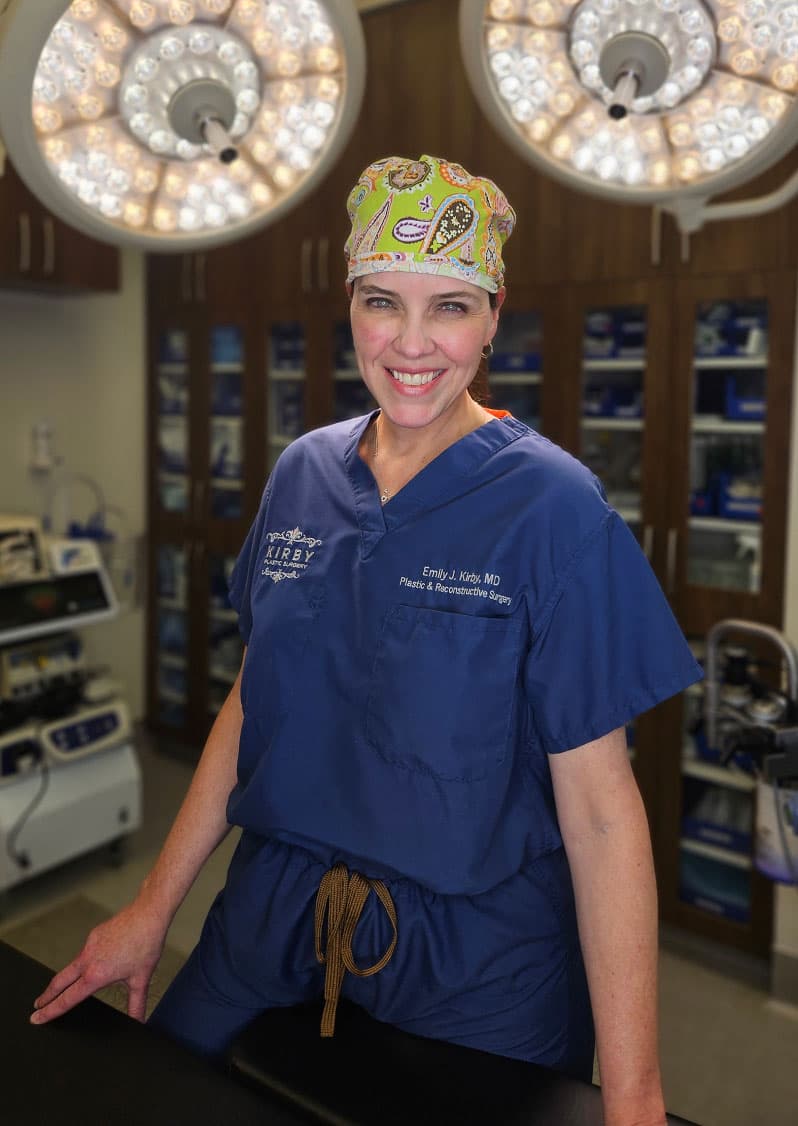Breast Reconstruction Fort Worth

Breast reconstruction is performed to restore breast shape and volume after the removal of a tumor or cancer from the breast. Patients may also choose to remove their breasts before any cancer has begun (a prophylactic mastectomy) if there is genetic testing done suggesting a high risk of cancer. Breast reconstruction can either be performed during the same surgery in which your breast tissue is removed (immediate) or months to years later (delayed).
It is never too late to reconstruct a breast
Board Certified Plastic Surgeon Dr. Emily J. Kirby uses several techniques to restore breast shape and volume, utilizing breast implants, expanders and fat grafting. If only one breast is reconstructed, it may be recommended that the other breast undergo a lift, augmentation, or reduction in order to attain symmetry. It is important to understand that your insurance company is required by the Women’s Health and Cancer Rights Act of 1998 to provide benefits in connection with a mastectomy, including symmetry surgery for the opposite breast. All stages of reconstruction are protected by this Act.
Female Plastic Surgeon Fort Worth
- Board-Certified Plastic Surgeon
- Over 12 years of experience in private practice
- Founder and Medical Director of Kirby Plastic Surgery, Kalos Medical Spa, and City Surgery Center—a Quad A-accredited, state-of-the-art facility located onsite
- Specialist in breast surgery and body contouring, including postpartum
- Castle Connolly Top Doctor since 2019
- First female Chief of Plastic Surgery, Texas Health Resources Harris Methodist Hospital
What will my breast reconstruction procedure be like?
If implant-based reconstruction is chosen, tissue expanders or permanent implants may be placed after your initial surgery. This may be immediately after your lumpectomy or mastectomy during the same operating room visit (immediate reconstruction), or it may be several months to years after your lumpectomy or mastectomy (delayed reconstruction). This decision will depend on your oncologist, your breast surgeon, and many other factors taken into consideration by Dr. Kirby in planning your surgery with you. Your nipples may or may not be preserved, depending on your surgical needs; this will be a decision made with you by Dr. Kirby and your breast surgeon prior to surgery. Dr. Kirby also utilizes a specialized device that allows her to “spy” on the chest wall blood supply during surgery to help determine which route can be chosen safely during surgery. Although sometimes unexpected issues arise, rest assured that all anticipated options will be discussed with you ahead of time.
Both permanent implants and tissue expanders are placed using acellular dermal matrix (ADM). Acellular dermal matrix, such as Alloderm™, is made from a layer of skin that has been treated to remove proteins so the tissue cannot be rejected. Your tissue grows into the material, which then becomes part of your tissue over the course of several months to 1 year. This material gives your body an extra layer between your skin and the implant, decreasing your risk of capsular contracture and improving the appearance of reconstruction. Use of this material in the breast is currently considered an off-label use of FDA-approved soft-tissue material.
Expanders and implants can be placed over or under the chest pectoralis muscles. When we place implants above the muscle, we are able to avoid chronic, long-term pain and the “animation” that often plagues many patients undergoing “submuscular” breast reconstruction. Animation occurs when an implant is placed underneath the pectoralis muscle, and scarring occurs that causes the implant to move or “animate” along with movements of the chest muscles. One downfall of placing implants above the muscle, however, is that there is typically more “rippling” of the implant, which may be only palpable or may also be visible. Rippling can be treated with fat grafting to decrease the appearance.
If tissue expanders are placed first, they are filled a bit to get started safely, then are slowly filled in the office on a weekly basis starting a few weeks after surgery in order to stretch the skin and soft tissue to make room for your permanent breast implants. You will determine with Dr. Kirby when you are close to the “right size.” Silicone (most common) or saline implants are then placed during a separate procedure. This process typically takes several months to complete.
- Key Benefits
- Glossary
- Restores breast shape and volume by rebuilding the breast mound
- Allows for nipple and areola reconstruction
- For those with one breast affected, reconstruction helps restore symmetry
- Highly unique, allowing options in reconstruction methods (i.e. implant-based or autologous tissue-based)
- Autologous Reconstruction: Breast reconstruction using the patient’s own tissue from another part of the body, such as the abdomen, back, buttocks, or thighs.
- Breast Implants: Medical devices made of silicone or saline used to reconstruct the breast shape after mastectomy or lumpectomy.
- Capsular Contracture: A potential complication of implant-based reconstruction where the scar tissue that naturally forms around the implant thickens unexpectedly, causing it to feel firm and possibly distorting the shape of the breast.
- Delayed Reconstruction: Breast reconstruction that is performed months or years after the initial mastectomy or lumpectomy, as opposed to immediate reconstruction, which is initiated during the same anesthetic, immediately following the breast surgeon’s procedure.
- Direct-to-Implant Reconstruction: A method of breast reconstruction where a permanent breast implant is placed directly after the mastectomy, without the need for tissue expansion.
- Expander-Implant Reconstruction: A staged reconstruction process that begins with the placement of a tissue expander to stretch the skin and create a pocket for a breast implant, followed later by the placement of the permanent implant.
- Flap Techniques: Surgical methods in autologous reconstruction that use the patient’s own tissue, including skin, fat, and sometimes muscle, to create a breast mound. Common flap techniques include the DIEP flap, TRAM flap, and LAT flap.
- General Anesthesia: Medication administered to induce sleep and relaxation during breast reconstruction surgery.
- Immediate Reconstruction: Reconstruction of the breast(s) during the same surgery as the mastectomy or lumpectomy, under the same anesthetic.
- Implant Rupture: A potential complication where a breast implant tears, which requires surgery to replace or remove the implant. Saline implants may also be intentionally ruptured for various reasons in preparation for surgery.
- Mastectomy: A surgical procedure to remove breast tissue from one or both breasts, partially or completely, most often due to cancer.
- Nipple-Areolar Reconstruction: A procedure to reconstruct the nipple and areola after breast reconstruction, in contrast to 3D tattooing that can also simulate the appearance of a natural nipple and areola.
- Prophylactic Mastectomy: Preventative removal of one or both breasts in patients at high risk for breast cancer, often followed by breast reconstruction.
- Reconstruction Revision: Additional surgery after the planned initial breast reconstruction to correct or improve the appearance of the reconstructed breast, which may include adjustments to size, shape, or symmetry.
- Tissue Expansion: A process using a device called a tissue expander to stretch the skin and tissue at the site of the mastectomy to make room for a breast implant, involving the gradual inflation of a tissue expander in the office.
Fat grafting can be added to several of the steps in breast reconstruction, if desired, to smooth out inconsistencies and ripples in the tissue after initial stages of breast reconstruction. Fat grafting has also been shown to improve problems associated with radiated skin. Fat grafting involves liposuction to remove excess fat from an area of the body, typically the abdominal wall or flank areas. The fat is then prepared gently and placed into the breast.
Nipple-areolar reconstruction is the final step to complete the appearance of a natural-looking breast. This can be done surgically by Dr. Kirby or non-surgically with 3D tattooing.
Tissue-based flap reconstruction of the breast uses tissues from your own body, typically the abdomen or back, to reconstruct your new breast(s). Patients who choose tissue-based reconstruction must have enough tissue in the right place on their body to create one or two breasts. Occasionally, flap reconstruction may be used in combination with implant reconstruction. Dr. Kirby no longer performs tissue-based reconstruction, but can discuss the option with you and may refer you to a local surgeon who performs these procedures regularly.
Depending on your personal breast history, you may be a candidate for one or more of these procedures.
Real patient images from Board-Certified Plastic Surgeon Dr. Emily Kirby
*Individual results may vary.
What kind of anesthesia will I have?
Breast reconstruction surgery is performed under general anesthesia for optimal comfort. This means that you will be asleep for the entire surgery. Regional blocks are often used as well, which ease discomfort after surgery. Blocks are performed by an anesthesiologist and can be done prior to surgery or after you are asleep.
How long will my breast reconstruction surgery last?
Implant-based breast reconstruction surgery, if performed alone, typically takes 1-3 hours for implant or tissue expander placement and is outpatient surgery, meaning you return home the same day. Tissue-based surgeries usually take longer and require an overnight stay. Immediate reconstruction surgery (for example, immediately following tumor removal or mastectomy) will also take longer and may require an overnight stay.

City Surgery Center
Our on-site, accredited surgical suite
Instead of heading to a hospital or other public surgical facility for your procedure, you can enjoy the privacy and luxury of our on-site operating room, designed to facilitate safe, top-quality care in a spa-like setting.
What are the risks of breast reconstruction?
Your decision to undergo breast reconstruction is a personal decision and should be made with a full understanding of the benefits and potential complications of the procedure. The possible risks of breast reconstruction include, but are not limited to, bleeding, infection, tissue loss, poor healing of incisions, and anesthesia risks. You should also know that your own breast skin may have difficulty healing following lumpectomy or mastectomy surgery.
The use of breast implants carries the risk of capsular contracture, implant rupture, and other implant-related complications. Serious complications are very rare, but include implant-associated anaplastic large cell lymphoma (ALCL), which is has been associated with textured implants. The risk of ALCL is 1:2,207-1:86,029(compare this to your risk of breast cancer, which is 1 in 8). Genetics and low-grade infection play a role in patients who develop ALCL. These situations may require additional surgery for repair. Implants are not meant to last a lifetime and come with the likelihood of having another surgery in the future.
“From the beginning, it was apparent that Dr. Kirby is a caring individual who was interested in my welfare and recovery.”
How do I prepare for surgery?
Prior to any procedure, it is necessary to review medications you are taking that may affect your surgery. You may be asked to stop or to adjust some medications you are on. As always, it is important to include supplements on your list of medications. Aspirin and aspirin products (Alka-Seltzer®, Carisoprodol, Excedrin®, Goody’s®, Midol®), anti-inflammatory medications (except acetaminophen, or Tylenol®), and herbal supplements must be avoided for 10 days prior to your surgery. For more details about which medications and supplements to avoid, click here. Dr. Kirby will discuss your medications with you.
Depending on your medical condition, you may be asked to get lab testing or a medical checkup prior to your surgery. You may also be asked to have an updated mammogram prior to your surgery if you have not had one recently.
Nicotine products impair your body’s ability to heal. You will be required to stop smoking for 6 weeks prior to surgery and 6 weeks after surgery. This includes all vaping devices. Tobacco step-down products such as chewing gum and Nicoderm® continue to provide your body with nicotine and must be stopped as well. Please ask Dr. Kirby if you will need assistance with quitting. Nicotine tests are routinely and randomly performed by Dr. Kirby’s team.
Be sure to arrange for a responsible adult to drive you to and from your surgery. You will need someone to stay with you for 24 hours following your surgery as well.
You will receive specific instructions for your surgery day from Dr. Kirby’s office.
Dr. Emily Kirby uses Enhanced Recovery After Surgery (ERAS) protocols, also known as “multimodal analgesia,” to minimize recovery time, and we see real results: our patients experience less nausea and feel more alert, mobile, and comfortable after their procedures.
“I had very hard recoveries in the past…it took me weeks to get back to caring for my family. With Dr. Kirby, I had a wonderful recovery and was back to my activities surprisingly quickly. Don’t tell the doctor, but I was at my child’s sporting event the day after my surgery, and I felt great!”
—Real patient of Dr. Kirby
What will recovery from breast reconstruction surgery be like?
Following your breast reconstruction surgery, you will notice that you have swelling, soreness, and some changes in sensation as well. Some breast sensation may return over time. You may be asked to wear a supportive or surgical bra following surgery as your breasts heal from the procedure. Dr. Kirby will discuss with you when your dressings will be removed and when to return for a post-operative visit, which is typically 7-10 days after surgery. If tissue expanders are placed, you will return to the office for the expanders to be filled on a regular basis until they are full.
Your specific surgery may require that you stay in the hospital overnight following surgery. Depending on your occupation, you can expect to return to work in 1-2 weeks. More strenuous activity, however, cannot be resumed until 4-6 weeks after surgery. You will be directed on scar massage techniques by Dr. Kirby and her team when the timing is appropriate. Your reconstructed breasts will continue to improve in the months following surgery.
References »
Colwell AS, Taylor EM. Recent Advances in Implant-Based Breast Reconstruction. Plastic and Reconstructive Surgery. 2020 Feb;145(2):421e-432e. doi: 10.1097/PRS.0000000000006510.
Graziano FD, Lu J, Sbitany H. Prepectoral Breast Reconstruction. Clinics in Plastic Surgery. 2023 Apr;50(2):235-242. doi: 10.1016/j.cps.2022.09.004.
von Fritschen U, Seidenstücker K, Sigalove S. Current trends in postmastectomy breast reconstruction. Current Opinion in Obstetrics and Gynecology. 2023 Feb 1;35(1):73-79. doi: 10.1097/GCO.0000000000000828.
Alessandri Bonetti M, Carbonaro R, Borelli F, Amendola F, Cottone G, Mazzocconi L, Mastroiacovo A, Zingaretti N, Parodi PC, Vaienti L. Outcomes in Hybrid Breast Reconstruction: A Systematic Review. Medicina (Kaunas). 2022 Sep 6;58(9):1232. doi: 10.3390/medicina58091232.
Cha HG, Kwon JG, Kim EK. Simultaneous Nipple-Areola Complex Reconstruction Technique: Combination Nipple Sharing and Tattooing. Aesthetic Plastic Surgery. 2019 Feb;43(1):76-82. doi: 10.1007/s00266-018-1247-2.
Vandeweyer E. Simultaneous nipple and areola reconstruction: a review of 50 cases. Acta Chirurgica Belgica. 2003 Nov-Dec;103(6):593-5. doi: 10.1080/00015458.2003.11679498.
Boccola MA, Savage J, Rozen WM, Ashton MW, Milner C, Rahdon R, Whitaker IS. Surgical correction and reconstruction of the nipple-areola complex: current review of techniques. Journal of Reconstructive Microsurgery. 2010 Nov;26(9):589-600. doi: 10.1055/s-0030-1263290.
- Discuss your goals and concerns
- Obtain a unique female perspective
- Review convenient financing options
- Call or TEXT (817) 292-4200, or contact us today
Area Served:

Medically reviewed by Dr. Emily J. Kirby — Updated on Apr 11, 2024
